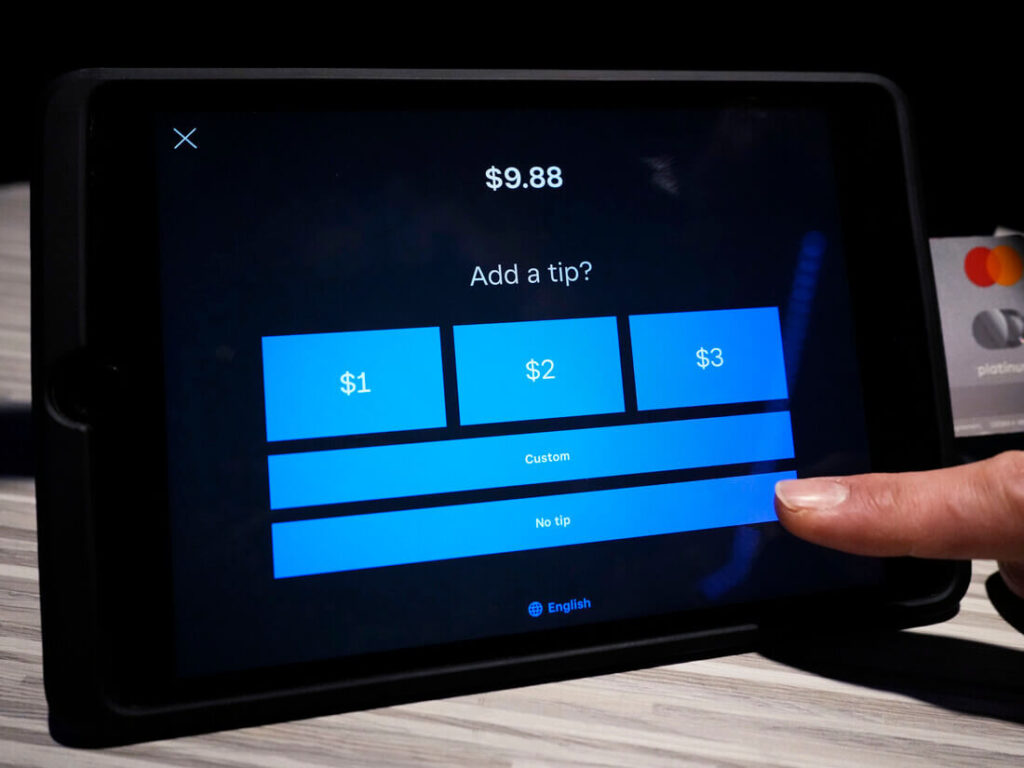Introduction to Tip Screen
A tip screen is a digital interface that allows customers to easily add a gratuity to their purchases, particularly in service-based industries like restaurants, cafes, ride-sharing, and personal services. These screens have become increasingly common as businesses adopt digital payment methods and point-of-sale (POS) systems.
Traditionally, tipping was done manually by the customer, either by leaving cash or writing the tip amount on the credit card slip. However, with the rise of digital payments, tip screens have evolved to provide a more streamlined and convenient tipping experience for both customers and service providers.
The Technology Behind Tip Screens
Tip screens are primarily integrated into point-of-sale (POS) systems, digital kiosks, tablet-based systems, and mobile payment apps. These technologies allow businesses to easily incorporate tipping options into their payment process.
POS integration enables businesses to customize tip screens to fit their specific needs, such as setting default tip percentages or allowing customers to enter custom amounts. Digital kiosks and tablet-based systems provide a user-friendly interface for customers to select their preferred tip option, while mobile payment apps like Square and Venmo have built-in tipping features for a seamless digital tipping experience.
The Impact of Tip Screens on Various Industries
Restaurants and Cafes
Tip screens have had a significant impact on the restaurant and cafe industry, particularly in differentiating between table service and counter service establishments. In table service restaurants, tip screens allow customers to easily add a gratuity to their bill, while in counter service establishments, tip screens are often used for counter orders and takeout.
The introduction of tip screens has also influenced server earnings, as customers are more likely to tip when prompted by a digital interface. However, some argue that this has led to “tipflation,” where tip percentages have increased over time, potentially putting financial strain on customers.
Ride-sharing and Taxi Services
Ride-sharing services like Uber and Lyft have integrated tipping into their mobile apps, allowing passengers to tip drivers directly through the app. This has made tipping more convenient and has become an expected part of the ride-sharing experience. Taxi services have also adopted digital tipping options, often through tablet-based systems installed in the vehicle.
In-app tipping has had a positive impact on driver satisfaction and retention, as tips make up a significant portion of their earnings. However, some drivers argue that tip screens have led to an expectation of higher tips, which can be challenging for passengers to meet.
Personal Services
Tip screens have also become common in personal service industries such as salons, spas, and other service-based businesses. These industries often use tablet-based systems or standalone tip screens to allow customers to easily add a gratuity to their service. Businesses can customize tip options to fit different service types, such as offering a higher default tip percentage for more complex or time-consuming services.
The Psychology of Tip Screens
Consumer Behavior and Tip Screens
Tip screens can create a sense of social pressure, as customers may feel obligated to tip in a public setting. The presence of default tip percentages on the screen can also influence customer behavior, with many customers opting for the middle or highest percentage out of habit or a desire to avoid confrontation.
Employee Perspectives
For employees, tip screens can be a source of motivation and job satisfaction, as they provide a more reliable stream of income. However, in team environments, the distribution of tips can be a source of tension, as businesses must establish fair and transparent policies for tip allocation.
Implementing Tip Screens in Your Business
Choosing the Right Tip Screen Solution
When implementing tip screens in your business, it’s essential to choose a solution that fits your specific needs. Standalone tip screens offer more flexibility and customization options, while integrated systems provide a seamless experience with your existing POS system. Consider factors such as ease of use, customization options, and compatibility with your current payment infrastructure.
Best Practices for Tip Screen Setup
When setting up your tip screens, establish appropriate tip percentages that align with your industry standards and customer expectations. Design user-friendly interfaces that clearly communicate the tipping process to your customers, and ensure that the screens are placed in a visible and accessible location.
Training Staff on Tip Screen Usage
Train your staff on how to explain the tip screen system to customers, handle technical issues, and answer any questions that may arise. Ensure that your staff is knowledgeable about your tipping policies and can effectively communicate them to customers.
The Financial Implications of Tip Screens
For Businesses
Tip screens can lead to increased overall tips and revenue for businesses, as customers are more likely to tip when prompted by a digital interface. However, businesses must also consider the transaction fees and system costs associated with implementing and maintaining tip screen technology.
For Employees
Tip screens have the potential to increase employee earnings, as they make it easier for customers to tip. However, employees must be aware of the tax implications of receiving tips and ensure that they are properly reporting their income.
For Customers
Tip screens require customers to budget for digital tips, which can add to the overall cost of their purchase. Customers should understand how tip calculations work and be aware of their options for opting out or entering custom tip amounts.
Overcoming Challenges with Tip Screens
Addressing Customer Concerns
To address customer concerns about tip screens, businesses should strive for transparency in their tip distribution policies and ensure that customers have the option to opt out or enter custom tip amounts. Clear communication and a user-friendly interface can help alleviate customer discomfort with the tipping process.
Technical Considerations
When implementing tip screens, businesses must ensure that the technology is compatible with their existing POS systems and that data security and privacy are maintained. Regular software updates and maintenance are essential to keep tip screen systems running smoothly.
Legal and Ethical Considerations
Businesses must comply with labor laws and ensure that tip distribution policies are fair and equitable. Establishing clear guidelines for tip allocation and communicating them to employees can help prevent disputes and ensure that tips are distributed fairly.
The Future of Tip Screens
Emerging Technologies
As technology continues to evolve, we can expect to see new developments in the world of tip screens. AI-powered tipping suggestions may provide customers with personalized tip recommendations based on factors such as service quality and total bill amount. Contactless and NFC-based tipping solutions may also become more prevalent, allowing customers to tip with a simple tap of their card or mobile device.
Expanding to New Industries
While tip screens are currently most common in service-based industries like restaurants and personal services, they may expand to new sectors in the future. As digital payments become more widespread, businesses in various industries may adopt tip screens to provide a more convenient and streamlined tipping experience for their customers.
Impact of tip screens on customer satisfaction
Increased Convenience and Encouragement to Tip
Tip screens simplify the tipping process by offering predefined options, enhancing customer satisfaction. They allow patrons to quickly select a tip amount without needing to calculate percentages or decide on gratuity on the spot. Digital tipping can increase the average tip by 11% to 20% compared to traditional methods.
Additionally, the presence of tip prompts creates a social expectation to tip, encouraging customers to express their appreciation for good service more readily. This aligns with findings suggesting customers often feel more inclined to tip when presented with the option, enhancing their overall dining experience.
Customer Irritation and Tipping Fatigue
The introduction of tip screens has led to “tipping fatigue,” where customers feel pressured to tip in situations they would not have previously, such as at counter-service restaurants or during quick transactions. This pressure can lead to feelings of guilt or irritation, especially if the suggested tip percentages are perceived as excessive.
Research shows that up to 32% of consumers express annoyance with pre-entered tip screens, and some even report tipping less or not at all when faced with these prompts. This irritation can sour an otherwise positive dining experience, leading to a decline in customer satisfaction.
The Balance of Expectations and Transparency
To mitigate the negative impacts of tip screens, restaurants need to communicate their tipping policies transparently. Customers should be informed about how tips are distributed—whether they are pooled among staff or go directly to individual servers. This transparency can help alleviate feelings of guilt or confusion regarding tipping expectations, fostering a more positive customer experience.
Maximize the benefits of tip screen
To maximize the benefits of tip screens, businesses should:
- Choose a tip screen solution that fits their specific needs and budget.
- Establish appropriate tip percentages and design user-friendly interfaces.
- Train staff on how to effectively communicate the tipping process to customers.
- Ensure transparency in tip distribution policies and compliance with labor laws.
- Stay informed about emerging technologies and industry trends to adapt and innovate as needed.
Conclusion
Tip screens have become an integral part of modern commerce, shaping customer service expectations and influencing tipping culture. By implementing tip screens effectively, businesses can balance customer experience and employee satisfaction while staying ahead in the digital payment landscape.
By embracing tip screens and adapting to the changing landscape of digital payments, businesses can enhance the customer experience, improve employee satisfaction, and position themselves for success in the future of commerce.
Also read: Blue Roses: Nature’s Unattainable Beauty
FAQs
How do tip screens affect customer satisfaction?
Tip screens can enhance customer satisfaction by providing convenience and encouraging tipping, but they can also create pressure and irritation among customers who feel obligated to tip.
What is “tip fatigue”?
Tip fatigue refers to the exhaustion or annoyance customers feel from being frequently prompted to tip, especially in situations where tipping was not traditionally expected, leading to negative feelings about the dining experience.
Do tip screens lead to higher tips?
Yes, research indicates that tip screens can increase the average tip amount, with some establishments reporting increases of 15% to 30% after implementing digital prompts.
How do customers perceive suggested tip percentages?
Many customers find suggested tip percentages to be too high, particularly in counter-service settings, leading to frustration and a tendency to tip less or not at all when faced with these prompts.
What role does transparency play in customer satisfaction with tip screens?
Transparency about how tips are distributed can alleviate customer concerns and enhance satisfaction. Clear communication about tipping policies helps customers feel more comfortable with the process.
How can restaurants mitigate negative reactions to tip screens?
Restaurants can mitigate negative reactions by offering lower default tip percentages, allowing customers to opt out easily, and ensuring that staff are trained to communicate the tipping process effectively.







